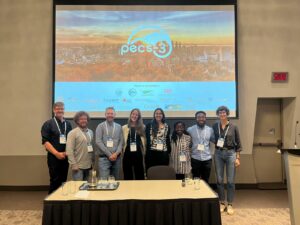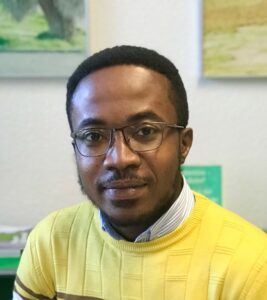Regeneration at multiple scales: How social-ecological modeling connects place-based interventions with planetary visions and pathways
Written by Paule Pamela Tabi Eckebil and edited by Frank Mintah Photo by Mr. Kwaku Owusu Twum

This blog post is part of a series reflecting on a selection of sessions and keynotes that were presented at the PECS-III Conference, Montreal Canada, 12-15 August 2024
Overview of the session
Chaired by Prof. Johannes Halbe, the session brings together social-ecological systems modelers to advance transformative research and practice at the intersection of multiple spatial scales and emphasise the importance of understanding the interconnectedness of social and ecological systems through the application of diverse concepts within the social-ecological systems field.
The session consists of seven fascinating talks addressing World-Earth System Modeling, Participatory Social-Ecological Modeling and Landscape Restauration Practice.
The talks delved into an approach that applies integrated World-Earth modeling to analyse regenerative pathways and visions at a planetary scale and learn how to revitalize World-Earth system resilience. Additionally, the regenerative agriculture concept was described as a system where farmers and governance actors can meet to improve the food system while reducing the carbon footprint of agricultural practices through transformative knowledge in Germany.
Place-based case studies were located in Latin America, West Africa, and Europe on social-ecological modeling of regenerative practices in forestry and agriculture. The talks share experiences with participatory modelling on people’s visions for sustainable future pathways for sustainable land management and leverage points that include the design of governance pathways through systems dynamics modelling.
In the context of peatland in Germany, a practical experience was shared in bringing regenerative landscape visions into reality comprising ecohydrological and social aspects.
Common reflections and analysis
Social-ecological modeling is a promising method to investigate complex interactions and emergent dynamics across scales. The main key messages of the session were:
- Regenerative land use practices inspiring positive planetary visions.
The first step is to gather empirical evidence to understand the context and contrast of practices, assess the positive effects on nature and humans, potential side-effects, and explore the opportunities for upscaling and combination with other practices. Next, leverage inspiration among stakeholders to make solutions tangible and plant seeds of positive visions at larger scales.
- Ways to upscale practices to enhance World-Earth system resilience
This step needs a deep and clear comprehension of “upscaling” and to what extent we need to upscale our initiatives, which is not always possible. The meaning of “upscaling” was seen more as moving from the local to the planetary. Along the way, this terminology entails the active engagement of stakeholders from diverse backgrounds, establishes dialogues among them, brings up innovative actions from local to larger scales and addresses the value dimension.
However, in engaging actors, one should consider some limits and complexity; in other words, selecting suitable indicators, being resilient and enhancing the capacity to deal with shocks and stresses at all levels. Lastly, ensure that the needs of vulnerable groups are heard and considered.
- Role of participatory social-ecological modeling in designing visions and interventions
Participatory social-ecological modeling can be crucial in designing visions and interventions by actively involving communities, stakeholders, and experts in understanding and addressing environmental challenges. Considering various social, cultural, economic, and ecological factors as inputs helps to create more comprehensive models.
Collaboration between stakeholders helps to develop shared visions for the future. During this process, stakeholders can discuss and build consensus, enabling them to align on goals and aspirations. Therefore, the interventions aim at being technically sound, socially acceptable, and supported by the most vulnerable. Communities are empowered to take ownership of interventions in their social-ecological systems. Any intervention that fosters a sense of agency and responsibility is also likely to be successful in the long run. Finally, decision-makers can gain a richer, more nuanced understanding of the systems they are responsible for.
Conclusion
The session on “Regeneration at Multiple Scales: Social-ecological modeling to connect place-based interventions with planetary visions and pathways” was a powerful reminder of the interconnectedness of our world. It showed that while local actions are vital, they gain even more significance when they are part of a broader, global strategy. Using tools like social-ecological modeling and focusing on place-based interventions can create a more sustainable future where local efforts contribute to global solutions. This session was an important step in understanding how to bridge the gap between individual actions and collective planetary well-being.
We are grateful to Prof. Dr Chinwe Ifejika Speranza, who was actively involved in the preparation and organisation of the session.


